
Bongcheon Station is a station on the Seoul Subway Line 2. It is located in Bongcheon-dong, Gwanak-gu, Seoul, South Korea, close to Gwanaksan Mountain.
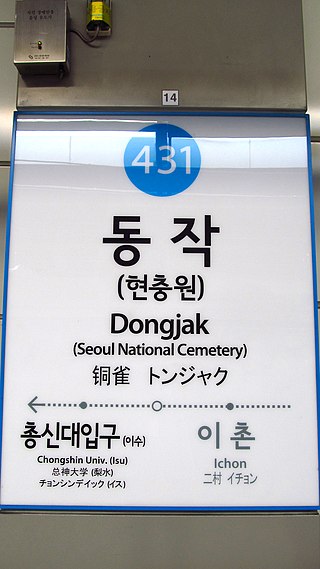
Dongjak Station is a station on Line 4 and Line 9 of the Seoul Subway. Express trains on Line 9 stop at this station. As the station's subname, This station serves the Seoul National Cemetery.
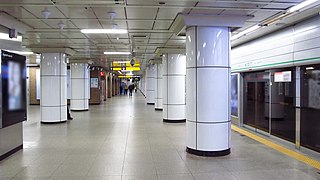
Sadang Station is a station on the Seoul Subway Line 2 and Seoul Subway Line 4 in South Korea.

Aeogae station is a subway station on Line 5 of the Seoul Metropolitan Subway. The station is located in the Ahyeon neighborhood of Mapo District, Seoul. The name Aeogae is notable for being one of the few station names in the Seoul Metropolitan Subway not derived from Chinese. The station name is derived from a native Korean word meaning "small ridge" and is shared by the neighborhood where the station is located.

Gimpo International Airport Station is a subway, railway and light rail station on Seoul Subway Line 5, Line 9, AREX, the Gimpo Goldline and the Seohae Line. True to its name, it serves the nearby Gimpo Airport, the hub of domestic flights in the Seoul metropolitan area as well as a limited number of regional international flights to and from China, Japan, and Taiwan. Upon its opening in 1996, it became the first railway station in the Korean Peninsula to directly serve an airport.

Hwaseo Station (Korean: 화서역) is a ground-level metro station on line 1 of the Seoul Subway in north-west Suwon, South Korea.
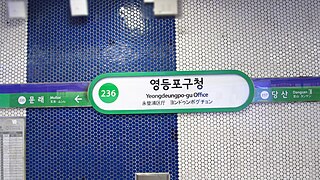
Yeongdeungpo-gu Office station is a station on Seoul Subway Line 2 and Seoul Subway Line 5. Before Mok-dong station on Line 5 was completed, this station served as a link to that neighbourhood via bus.

Hapjeong Station is a subterranean station of Seoul Subway Line 2 and Seoul Subway Line 6. The station is located just north of the Han River in Mapo-gu. The name of the subway station comes from its local name. The name of the area means clam well.
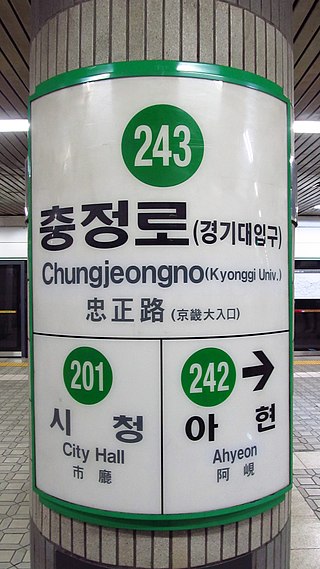
Chungjeongno Station (Korean: 충정로역) is a subway station on Seoul Subway Line 2 and Seoul Subway Line 5. It is located in Seodaemun-gu, which is a district in Seoul, South Korea. Chungjeong was the pen name of minister Min Yeong-hwan, who committed suicide protesting the signing of the Japan–Korea Treaty of 1905.

Noryangjin Station is a metro station in central Seoul, South Korea. The station is located in the Noryangjin-dong (neighborhood) of Dongjak-gu (ward) and is also a stop on Seoul Subway Line 1 and Seoul Subway Line 9. This stop is a popular destination for those seeking to eat raw fish, and other assorted seafood, as a large, covered sea food market is located next to the station, accessible by foot bridge. The Line 1 station is also notable in that Exit 1 and 2 have the same number as Exit 1 and 2 of Line 9's station.

Guro Station (Korean: 구로역) is a subway station in Guro District in Seoul, South Korea. It serves Seoul Subway Line 1.
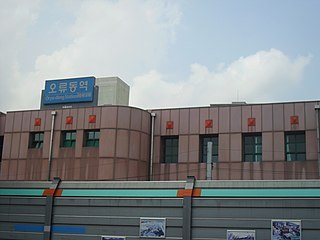
Oryu-dong station is a metro station on Line 1 of the Seoul Subway. It was opened when the Seoul–Incheon line was first introduced during the Japanese occupation era.
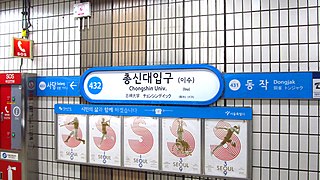
Isu Station is a subway station on the Seoul Subway Line 4 and Line 7 in Dongjak-gu, Seoul, South Korea.

Onsu Station is a station on the Seoul Subway Line 1. It was the former western terminus of Seoul Subway Line 7. A westward extension of Line 7 was completed in October 2012. It is near the border of Seoul and Bucheon.
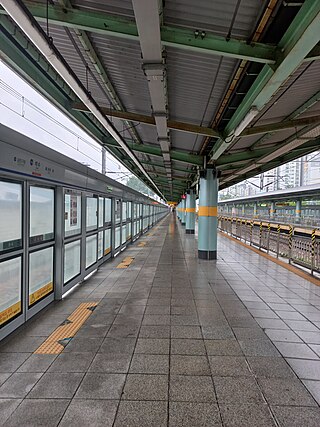
Seoksu Station is a station on Seoul Subway Line 1. It is situated on the border of Seoul and Anyang, the station building itself lying in Anyang, hence the address and indeed its name, which is derived from the area of Anyang in which it is located, and the platforms being in Seoul.

Doksan Station is a station on Line 1 of the Seoul Subway. It is an above-ground station located in southwestern Seoul, with service between Uijeongbu and Suwon/Cheonan.

Gwacheon Station (Korean: 과천역) is a station on the Seoul Subway Line 4. Despite its name, it is not the principal train station serving the city of Gwacheon; the next station on Line 4 is.

Gojan Station is a commuter train station on Seoul Subway Line 4 and the Suin–Bundang Line in Ansan, Korea. It is the closest station to Ansan Wa~ Stadium. Its station subname is Korea Univ. Ansan Hospital, as it is located nearby the station. The word "Gojan" originated as "inside of cape".

Seoul City Hall is a governmental building for the Seoul Metropolitan Government in South Korea, in charge of the administrative affairs of Seoul. It is located in Taepyeongno, Jung-gu, at the heart of Seoul. It is connected to City Hall Station (Seoul) on Seoul Subway Line 1, with access to Seoul Subway Line 2 from the same station. In front of the current city hall is the old city hall building, now Seoul Metropolitan Library, and Seoul Plaza.
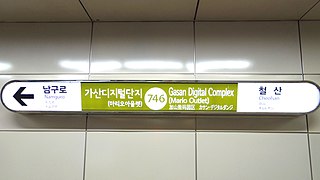
Gasan Digital Complex Station is on Gyeongbu Line, Seoul Metropolitan Subway Line 1 and Seoul Metropolitan Subway Line 7. Its former name is Garibong Station.





















